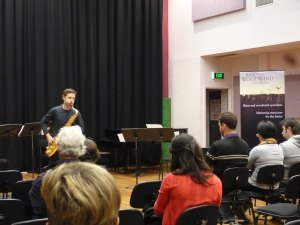I’ve recently been amazed by the number of saxophone ensembles forming and working around Australia in the last couple of years. For so long Continuum Sax seemed to be more or less alone in pushing this kind of music making, but no longer! In Tasmania, Queensland, NSW and Western Australia there are new groups forming and each one is doing something different. Thankfully, nobody seems to be doing quite the same thing.
First of all, I’d like to mention 22SQ from Tasmania, a group comprising Benjamin Price, Georgina Smith, Mitchell Ellis and Nicholas Nugent. Since they formed from among the students at the Tasmanian Conservatorium, the plaudits have been many. At the start of 2011 they performed at the inaugural MONA FOMA festival and played the Philip Glass Quartet for Philip Glass. In July of 2011 they played Glass’ Concerto for saxophone quartet and orchestra with the Tasmanian Discovery Orchestra and performed the Glass Quartet (and other things) at the Australian Clarinet and Saxophone Festival. They will release their first CD in November through the Tasmanian Conservatorium, which features Quartets by Glass, Glazunov, and Singelee as well as the Kastner Sextuor (with some important friends, I believe). The most exciting thing about looking at 22SQ is how much they’ve been able to generate excitement and opportunities within their local community. You sense that Tasmania feels like it owns this group and that they are intent on being ambassadors for everyone on their home patch.
I’ve been alerted to a new group called Just Sax from Perth. Specialising in light, tuneful, jazzy repertoire, they’ve got about eighteen clips on YouTube and are obviously working hard at getting more work together. With American style music stand covers, they look and sound like good wholesome fun, and even try to get some choreography going in their clips. Using jazz mouthpieces and not being afraid to let loose, they have that touch that audiences will immediately appreciate, something that is often difficult to develop.
In Queensland, the students at the QCGU have a wonderful saxophone ensemble and some interesting quartets forming from amidst its ranks. The QCGU Saxophone Ensemble arrange a lot of their own music, have some incredible composers in their midst and are hoping to pull it all together to go to St Andrews for the World Saxophone Congress in 2012.
The main saxophone quartet in Brisbane is currently Barega, whose current members are Chris Ball, Emma di Marco, Andrew Ball and Diana Tolmie. Their repertoire covers everything from the Tango Virtuoso by Escaich to the Ligeti’s Bagatelles. Performing major modern works to their Brisbane/Queensland audiences is an important task and Barega are relishing the challenge. The links between Barega and the Queensland Con and the QCGU Sax Ensemble make the scene in Brisbane healthy and vibrant.
In Sydney the scene is also burgeoning. Apart from Continuum Sax it’s worth mentioning three quartets, one with a long history and two which started just in 2010/11. Firstly, Nexas (Ben Carey, Andrew Smith, Nathan Henshaw and Jonathan Byrnes) have had a career that is marked by breaks when one or more of its members have been overseas. The group has specialised in contemporary modernist repertoire and new Australian works. They produced a CD for KammerKlang in 2010 with works by student composers but as yet, they haven’t recorded their primary artistic vision. Like many groups formed at University, Nexas have often seemed to be at a cross-roads where their individual careers have pulled in directions contrary to the trajectory of the group. A frustrating situation for both the members of the ensemble and their audience.
More recently, members of Nexas have diverged into other ensembles which have a very different focus. The Sax Summit is a sax quartet with drums marketing themselves to the function circuit. They play classic rock and pop from memory and choreograph their performances – almost a burlesque show. They did a lot of concerts at the Victoria Ballroom in Kings Cross as a way of fine-tuning their product and have managed to get a roll on with gigs.
Allianza Saxophone Quartet is made up of Rebecca Grubb, Joanne Carey, Carmen Nieves and Jonathan Byrnes and are programming works mainly from the canon of quartet literature. Recent performances have included the works of Pierne, Decruck and Bozza. This new group has great potential and I’m looking forward to seeing them grow in the future.
At Sydney Conservatorium of Music, ensemble playing is moving along very strongly. Since arriving, Michael Duke has formed a quartet from his masters students and performed regularly at the SCM and toured to China twice. The current students at SCM are building a number of promising groups that are taking advantage of all the opportunities that SCM can provide. More will no doubt be forthcoming.
Do write and let me know about other Australian sax quartets. I’d love to hear from any that I’ve missed and hear the music that you’ve been making.


